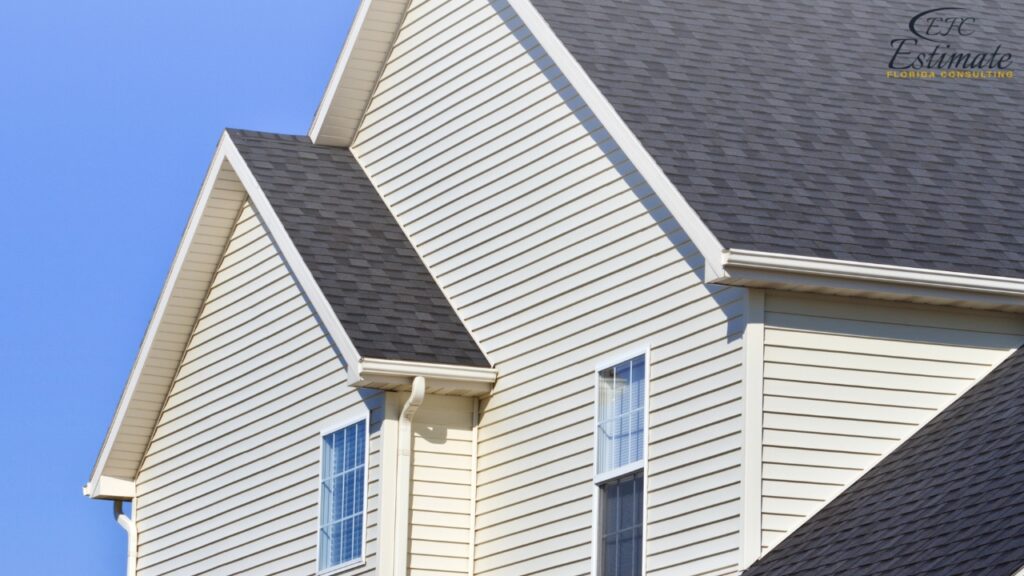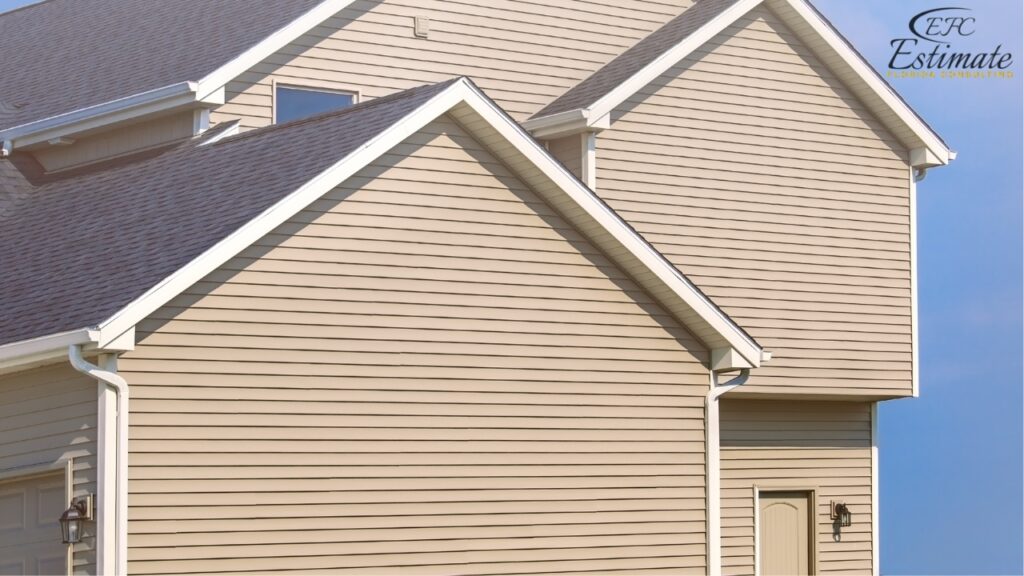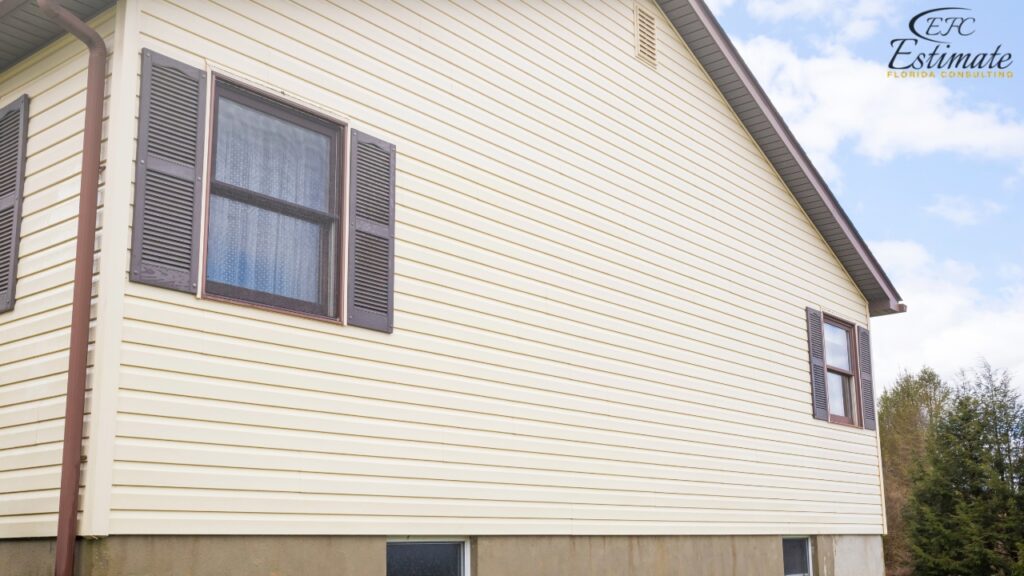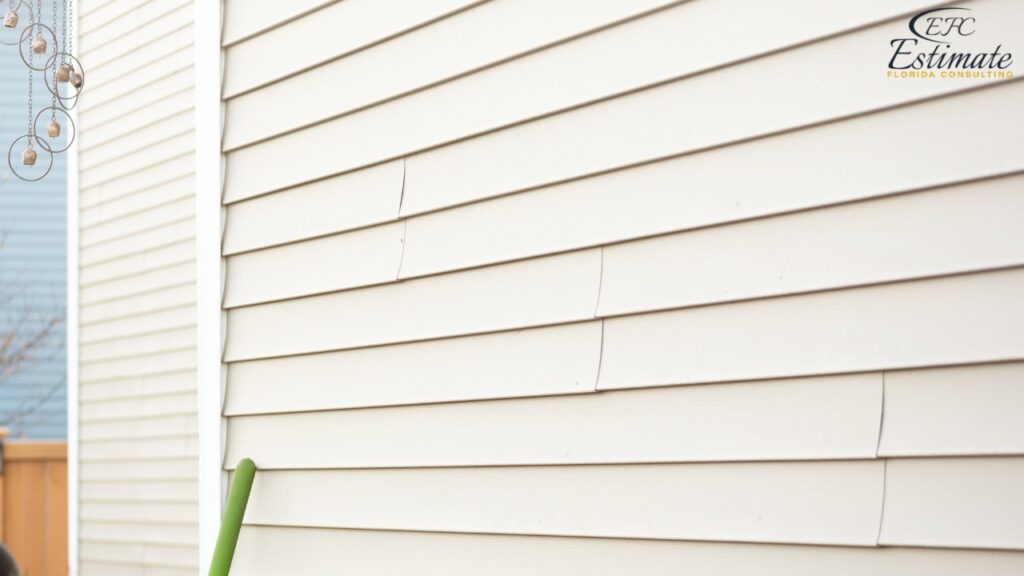How Much Is Vinyl Siding for a 2,500 Sq Ft House?
Vinyl siding for a 2,500 sq ft house typically costs between $59,780 and $94,340, translating to $23.91 to $37.74 per square foot. This total cost includes materials, labor, permits, and additional expenses such as insulation and removal of old siding. Lower-end costs cover basic vinyl siding and standard installation, while higher-end costs involve premium vinyl options, custom colors, and added insulation. Factors influencing the cost per square foot include the quality of the vinyl, design complexity, local labor rates, and any additional features or finishes. Proper planning and budgeting for unforeseen expenses ensure the project stays within the estimated cost range.

Cost Breakdown for Vinyl Siding a 2,500 Sq Ft House
Materials
The cost of vinyl siding materials can vary based on the quality, style, and brand. Here’s a detailed breakdown of typical material costs for a 2,500 sq ft house:
Vinyl Siding Material | Estimated Cost per Sq Ft | Total Cost for 2,500 Sq Ft |
Basic Vinyl Siding | $5.88 – $9.80 | $14,700 – $24,500 |
Mid-Grade Vinyl Siding | $9.80 – $11.76 | $24,500 – $29,400 |
High-End Vinyl Siding | $11.76 – $13.72 | $29,400 – $34,300 |
Basic Vinyl Siding
Basic vinyl siding offers an affordable option for homeowners who need a cost-effective solution. While it may lack some of the advanced features of higher-end products, it still provides solid protection and an improved appearance for your home. Basic vinyl siding is a great option for those who need to stick to a tight budget without sacrificing quality. It offers a clean, attractive finish and is available in a variety of standard colors and styles. Despite its lower cost, basic vinyl siding can still enhance your home’s exterior and provide adequate protection against the elements.
Mid-Grade Vinyl Siding
Mid-grade vinyl siding strikes a balance between cost and quality. It offers enhanced durability, a broader range of styles and colors, and often includes additional features such as better insulation. This option is ideal for homeowners who want a more durable and visually appealing product without the premium price tag. Mid-grade vinyl siding typically provides better resistance to weather and UV rays, maintaining its color and appearance longer than basic options. This level of siding is perfect for those looking for a blend of affordability and quality, offering more customization options and a longer lifespan.
Basic Vinyl Siding
Basic vinyl siding offers an affordable option for homeowners who need a cost-effective solution. While it may lack some of the advanced features of higher-end products, it still provides solid protection and an improved appearance for your home. Basic vinyl siding is a great option for those who need to stick to a tight budget without sacrificing quality. It offers a clean, attractive finish and is available in a variety of standard colors and styles. Despite its lower cost, basic vinyl siding can still enhance your home’s exterior and provide adequate protection against the elements.

High-End Vinyl Siding
High-end vinyl siding represents the top tier of vinyl siding options. It includes premium features such as advanced insulation, a wide array of styles and colors, and enhanced durability. This option is perfect for homeowners who want the best quality and are willing to invest more upfront for long-term benefits. High-end vinyl siding can mimic the appearance of more expensive materials like wood or stone, providing a luxurious look without the high maintenance. This type of siding often comes with extended warranties and additional features that enhance both its aesthetic appeal and functional performance.
Labor Costs
Labor costs for installing vinyl siding can vary depending on the complexity of the project, the contractor’s rates, and the region. Here’s an estimate of labor costs:
Labor Task | Estimated Cost per Hour | Total Cost for 2,500 Sq Ft |
Site Preparation | $98 – $137.20 | $2,450 – $3,430 |
Siding Installation | $137.20 – $196 | $34,300 – $49,000 |
Trim and Accessory Installation | $98 – $137.20 | $2,450 – $3,430 |
Cleanup and Inspection | $78.40 – $117.60 | $1,960 – $2,940 |
Site Preparation
Site preparation involves clearing the area, removing old siding, and ensuring the surface is ready for new siding installation. Proper site preparation can prevent issues such as uneven surfaces or moisture problems, which can affect the siding’s performance and longevity. This stage may also include making necessary repairs to the underlying structure to ensure a stable base for the new siding. Ensuring the site is adequately prepared can also help avoid delays during the installation process. Thorough preparation can mitigate potential complications and ensure that the new siding adheres properly. Proper site preparation is crucial for achieving a smooth, high-quality finish.
Siding Installation
The installation of new siding requires skilled labor to ensure proper alignment, secure attachment, and a neat finish. The cost for this labor can vary based on the complexity of the job and the rates in your area. Skilled installation is vital for the siding to perform as expected, providing protection and enhancing the home’s appearance. Professional installation can also help ensure that the siding’s warranty remains valid. Proper installation techniques are crucial for maximizing the lifespan and effectiveness of the siding. Quality installation can also improve the energy efficiency of the home by ensuring a tight seal around the structure.
Trim and Accessory Installation
Installing trim and accessories is necessary to complete the siding installation. This step ensures that all edges and corners are sealed, preventing water infiltration and creating a finished look. Proper installation of trim and accessories is essential for the siding’s overall effectiveness and aesthetic appeal. Trim and accessories can also help protect the edges of the siding from damage and extend its lifespan. The detailed work involved in installing these elements can significantly enhance the overall appearance and functionality of the siding. High-quality trim can also add decorative elements to the home, enhancing its visual appeal.
Cleanup and Inspection
After the installation is complete, cleanup and inspection are necessary to ensure the job is done correctly and the site is left tidy. This step includes removing debris, inspecting the installation for any issues, and making any necessary adjustments. A thorough cleanup and inspection ensure that the siding installation meets quality standards and that the site is safe and presentable. This final step also helps ensure that the homeowner is satisfied with the finished project. Addressing any issues promptly can prevent future problems and ensure the siding performs optimally. Proper cleanup and inspection are essential for maintaining the appearance and integrity of the new siding.
Additional Costs
Additional costs can include permits, inspections, and any custom features or finishes. Here’s an estimate of these costs:
Additional Component | Estimated Cost |
Permits and Inspections | $980 – $1,960 |
Custom Finishes | $1,960 – $5,880 |
Miscellaneous Expenses | $980 – $2,940 |
Permits and Inspections
Obtaining the necessary permits and passing inspections are crucial steps in the siding replacement process. These fees can vary depending on local regulations and the complexity of the project. Ensuring that all permits are obtained and inspections passed is essential for compliance with building codes and safety standards. This process can also help avoid potential legal issues down the line. Working with experienced contractors who are familiar with local permitting requirements can streamline this process. Ensuring compliance with local codes can prevent costly fines and delays. Properly managing the permitting process ensures that the project meets all legal and safety requirements.

Custom Finishes
Custom finishes can include special coatings, colors, or designs that enhance the appearance of the siding. These finishes can add to the overall cost but provide a unique look and additional protection. Investing in custom finishes can increase the curb appeal and value of your home, making it stand out and offering added durability. Custom finishes can also include treatments that make the siding more resistant to weather and environmental factors. Choosing high-quality finishes can enhance the longevity and performance of the siding, ensuring that it remains attractive and functional for many years.
Miscellaneous Expenses
Miscellaneous expenses can include unexpected costs that arise during the project, such as additional materials, equipment rentals, or unforeseen repairs. Having a contingency budget for these expenses helps ensure the project stays on track and can handle any surprises without significant delays or cost overruns. Properly managing these costs can prevent disruptions and ensure the smooth completion of the project. This category also covers any additional labor required for unforeseen tasks, ensuring that the project can adapt to any challenges that may arise.
Get 5 New Leads Next 7Days With Our System
- Multi-Family Building
- Hotel Building
- Hospital Building
- Warehouse Building
- High-Rise Building
- Shopping Complex
Cost Comparison by Siding Material
Here’s a comparison of the total estimated costs for siding a 2,500 sq ft house with different materials
Siding Material | Total Material Cost | Total Labor Cost | Total Cost |
Vinyl Siding | $14,700 – $34,300 | $41,160 – $58,800 | $59,780 – $94,340 |
Fiber Cement Siding | $21,000 – $36,750 | $41,160 – $58,800 | $62,160 – $95,550 |
Wood Siding | $21,000 – $31,500 | $41,160 – $58,800 | $62,160 – $90,300 |
Brick Veneer Siding | $31,500 – $52,500 | $41,160 – $58,800 | $72,660 – $111,300 |
Stucco Siding | $26,250 – $42,000 | $41,160 – $58,800 | $67,410 – $100,800 |
Steel Siding | $27,750 – $39,900 | $41,160 – $58,800 | $68,910 – $98,700 |
Factors Influencing Vinyl Siding Costs
Home Design and Structure
The design and structure of your home can significantly impact the cost of siding installation. Homes with complex architectural features, multiple stories, or irregular shapes may require more labor and materials, increasing the overall cost. Additionally, homes with many windows, doors, and corners will need more trim and accessory work, further driving up expenses. The overall complexity of the home’s design can add significant costs due to the additional labor and materials required to ensure a seamless installation.
Geographic Location
The geographic location of your home can affect both material and labor costs. Areas with a higher cost of living typically have higher prices for materials and labor. Additionally, the availability of certain materials may vary by region, impacting the overall cost. Obtaining quotes from multiple contractors in your area can help you get a better understanding of local pricing. Regional differences in climate and building codes can also influence the type of siding best suited for your home, potentially affecting overall costs.
Existing Siding Removal
If your home has existing siding that needs to be removed before the new siding can be installed, this will add to the overall cost. Removal and disposal of old siding can be labor-intensive and may require additional fees for waste disposal. The condition of the existing siding and the ease of removal can also affect costs. Proper removal and disposal of old siding are necessary to ensure a clean and smooth surface for the new siding installation.
Quality of Materials
The quality and type of materials used for vinyl siding can significantly impact the overall cost. High-end materials, while more expensive, offer better durability, insulation, and aesthetic appeal. Investing in high-quality siding materials can result in long-term savings through reduced maintenance and improved energy efficiency. Additionally, higher-quality materials often come with longer warranties, providing added peace of mind.
Contractor Experience
The experience and reputation of the contractor you hire can also affect the cost. Experienced contractors with a proven track record may charge higher rates, but they often deliver superior workmanship and reliability. Investing in a reputable contractor can prevent costly mistakes and ensure that the installation is completed correctly and efficiently. Obtaining references and checking reviews can help you select a contractor who offers the best value for your investment.
Benefits of Vinyl Siding
Affordability
Vinyl siding is one of the most cost-effective options available, making it an attractive choice for budget-conscious homeowners. Its affordability does not compromise its quality, as it provides excellent durability and longevity. When comparing vinyl siding to other materials, the initial cost savings are significant, allowing homeowners to allocate their budget to other important home improvement projects. Additionally, vinyl siding often comes with warranties, providing long-term value and peace of mind. This affordability makes it accessible for a wide range of homeowners, from those with limited budgets to those looking for cost-effective solutions for large projects.

Low Maintenance
One of the main advantages of vinyl siding is its low maintenance requirements. Unlike wood siding, which needs regular painting and sealing, vinyl siding only requires occasional cleaning with soap and water to maintain its appearance. This ease of maintenance saves homeowners time and money in the long run. Vinyl siding is also resistant to pests and rot, further reducing the need for repairs and upkeep. The low maintenance aspect of vinyl siding makes it an ideal choice for busy homeowners who want a beautiful exterior without the hassle of frequent maintenance. Its resilience to weather conditions also means fewer repairs and replacements over the years.
Versatility
Vinyl siding comes in a wide variety of colors, styles, and textures, allowing homeowners to customize their home’s exterior to match their personal preferences and the architectural style of the house. This versatility makes it easy to find vinyl siding that complements your home. Whether you prefer a traditional look or a more modern aesthetic, vinyl siding offers options that can meet your needs. The ability to mix and match different styles and colors also allows for a unique and personalized appearance that can enhance the overall curb appeal of your home. This flexibility in design ensures that homeowners can achieve the exact look they desire.
Durability
Vinyl siding is resistant to moisture, pests, and rot, making it a durable option that can withstand various weather conditions. Its longevity ensures that your home remains protected and looking good for many years. Vinyl siding is engineered to withstand high winds, extreme temperatures, and even hail, making it a reliable choice for homes in diverse climates. Additionally, vinyl siding does not warp or crack over time, maintaining its structural integrity and appearance with minimal effort. This durability translates into long-term cost savings, as homeowners won’t need to replace or repair the siding frequently. The robust nature of vinyl siding also means it can provide excellent protection against external elements.
Cost-Saving Tips
Here are some tips to help you save on vinyl siding costs:
Obtain Multiple Quotes
Getting multiple quotes from different contractors can help you find the best price for your siding project. Be sure to compare not only the overall cost but also the scope of work and the quality of materials being offered. This approach can also help you negotiate better terms and identify the most reliable contractors. Comparing quotes can reveal significant differences in pricing and services, allowing you to make an informed decision.
Choose Cost-Effective Materials
While high-end materials offer many benefits, choosing a more affordable option like basic or mid-grade vinyl siding can help reduce costs. Consider your budget and the long-term maintenance requirements when selecting a siding material. Opting for cost-effective materials doesn’t mean compromising on quality, as many affordable options still provide excellent durability and appearance.
Plan for Off-Season Installation
Scheduling your siding installation during the off-season can sometimes result in lower labor costs. Contractors may offer discounts during slower periods to keep their crews busy. Off-season installation can also lead to quicker project completion, as contractors typically have more availability. Planning your project for the off-season can lead to significant savings and faster turnaround times.
Do Some Work Yourself
If you have the skills and time, doing some of the preliminary work, such as site preparation or cleanup, can help reduce labor costs. However, be sure to leave the actual siding installation to the professionals to ensure it is done correctly. Taking on some tasks yourself can significantly lower overall costs without affecting the quality of the installation.
Download Template For Siding Project Breakdown
- Materials list updated to the zip code
- Fast delivery
- Data base of general contractors and sub-contractors
- Local estimators

Conclusion
Vinyl siding is a cost-effective and low-maintenance option for siding a 2,500 sq ft house. Understanding the various costs involved, including materials, labor, and additional expenses, can help you plan your project effectively and ensure it stays within budget. By considering the benefits of different vinyl siding options and the associated costs, homeowners can make informed decisions that best suit their needs and preferences. Proper planning and budgeting can help avoid unexpected expenses and ensure a successful siding installation. Investing in high-quality materials and skilled labor will result in a long-lasting, low-maintenance siding solution that adds value and curb appeal to your home. By following the tips and guidelines outlined in this guide, you can achieve a successful and cost-efficient siding project.
FAQs
The cost of vinyl siding for a 2,500 sq ft house can range from $59,780 to $94,340, depending on the quality of materials and labor costs.
Labor costs include site preparation, siding installation, trim and accessory installation, and cleanup and inspection. The total labor cost can range from $41,160 to $58,800.
Additional costs may include permits and inspections ($980 – $1,960), custom finishes ($1,960 – $5,880), and miscellaneous expenses ($980 – $2,940).
Here’s a comparison of costs for different siding materials:
- Vinyl Siding: $59,780 – $94,340
- Fiber Cement Siding: $62,160 – $95,550
- Wood Siding: $62,160 – $90,300
- Brick Veneer Siding: $72,660 – $111,300
- Stucco Siding: $67,410 – $100,800
- Steel Siding: $68,910 – $98,700
Proper site preparation ensures a smooth installation surface, prevents moisture problems, and can prevent delays and complications during the installation process.
High-end vinyl siding includes premium features like advanced insulation, more style and color options, and enhanced durability, mimicking expensive materials like wood or stone.
A reputable contractor ensures superior workmanship, reliability, and adherence to warranty requirements, preventing costly mistakes and ensuring the installation is done correctly.
Google Reviews



Process To Get Vinyl Siding for a 2,500 Sq Ft House Estimate Report
Here I am going to share some steps to get vinyl siding for a 2,500 sq ft house estimate report.
-
You need to send your plan to us.
You can send us your plan on info@estimatorflorida.com
-
You receive a quote for your project.
Before starting your project, we send you a quote for your service. That quote will have detailed information about your project. Here you will get information about the size, difficulty, complexity and bid date when determining pricing.
-
Get Estimate Report
Our team will takeoff and estimate your project. When we deliver you’ll receive a PDF and an Excel file of your estimate. We can also offer construction lead generation services for the jobs you’d like to pursue further.

